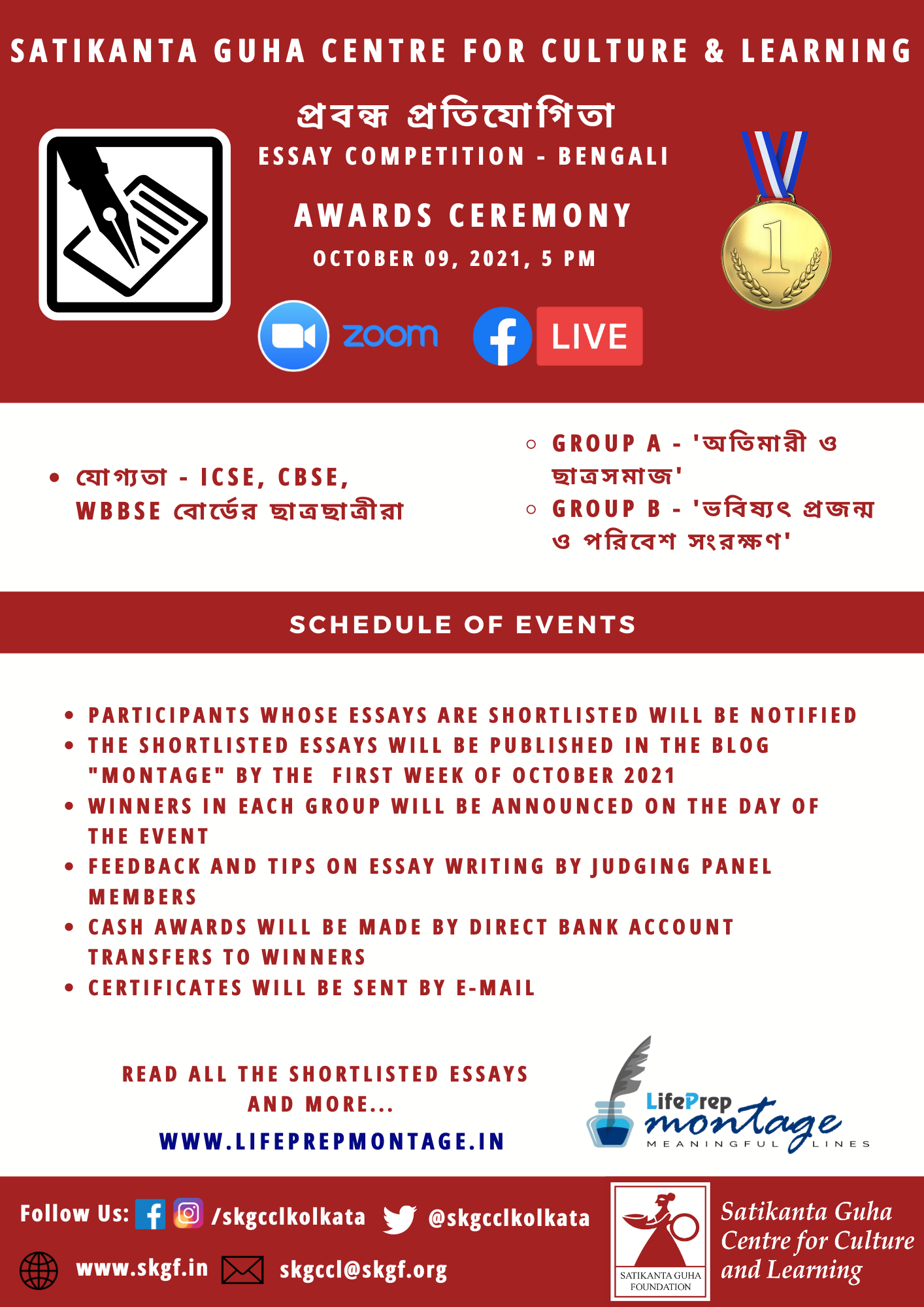Amitava Nag
Film Critic, Kolkata, India
Originally published in Rupkatha Journal on Interdisciplinary Studies in Humanities (ISSN 0975-2935), Vol 2, No 4, 2010 – Special Issue on Rabindranath Tagore
Abstract
This paper deals with Rabindranath Tagore’s 1916 novel Chaturanga and the film version of it made ninety two years later. Undoubtedly one of the most complex novels of Tagore, Chaturanga deals with individualism in confrontation with radical spiritualism and social rationalism. To achieve this, he took refuge to Freudian interpretation of eroticism in dreams, weaving a complex tapestry of love and life. Suman Mukhopadhyay’s film with the same name is extremely important since he tried to make a period film out of the novel relying largely on the universality of appeal of it. The article tries to bring to fore the parallels between the two media – not necessarily qualifying any but trying to look holistically at the contemporariness of Tagore’s characters.
Rabindranath Tagore’s Chaturanga (1916) having four chapters were originally published separately in consecutive issues of Sabujpatra (November 1915 – February, 1916). The four chapters integrate to the quartet in the form of a novel as it exists. The first of the chapter Jyathamosai is loosely coupled in the sense that such an elaborate preamble probably could have been dispensed with in lieu of a shorter introduction of the agnostic positivism of Jyathamosai imbibed from the Western culture. However, given that the four chapters are in a sense complete in themselves and still reaching out to the other chapters, this elaboration on Jyathamoshai does make sense. However, Chaturanga primarily is a novel of Sachis, Sribilas and Damini. It is interesting with respect to the Jyathamosai episode, how Lilananda Swami didn’t feature separately. It doesn’t miss the eye of the involved reader – the author’s positioning of his voice in illustrating Jyathamosai in positive light where in keeping Lilananda Swami’s religious overtures intermixed with other chores and to an extent in darker shades.
For Tagore who had written the nationalist novel Ghare Baire the same year, it is even more intriguing to find him delve in the spiritual quest of humanity in Chaturanga. Henceforth, whereas Ghare Baire remains a period piece set in the nationalist freedom struggle of British India, Chaturanga is timeless. Apart from a reference of plague turning out into a massacre in the city of Calcutta, nowhere else we can find any reference of any periodicity imbibed in the novel. The only periodicities that one can refer to are bleak in their social settings – markers of the social practices and behaviors.
This classic element in Chaturanga makes it a candidate for re- interpretations, and reviews even long after it was actually penned. Tagore being a favourite amongst the Bengali film-makers, it was rather long that Suman Mukhopadhyay finally made a film out of this complex novel as late as 2008.
Santanu Biswas in his paper on Tagore’s rendition of Freudian thoughts comments about Kalidas Nag and Tagore’s communication on the subject.
According to Nag, in reply to his question on the novel Chaturanga (Four parts) (1916), Tagore first ‘explained in detail the relationship between Sachis, Damini and Sribilas (three of the important characters)’ and then went on to say the following:
“To the authors of yesteryears life meant desire and frustration, union and separation, birth and death, and certain other similarly imprecise events. Therefore, the play called life had to end either in a cherished and revered union, or with a scene devoted to death’s vast graveyard. Since a few days now, our impression of our life has been changing—it seems we were so long loitering about the entrance—after a long time we seem to have discovered the way to the inner chambers for the first time. We are awake at the outer side of our consciousness—there we are consciously fighting battles, striking others and are being struck by others. But within these strikes and counter strikes, these ups and downs, something is being created in our ignorance of it. The arena for that gigantic game of creation is our submerged consciousness [magnachaitanyalok]. It is a new world, as if gradually coming into existence before us” (i)
This is important since in the later part of the novel in an extremely important juncture we find Sachis, Damini and Sribilas spending the night in a cave and Sachis having an erotically libidinal dream. The positioning of a cave as a vaginal symbol and hence that of fertility – the womb where Sachis and Damini’s relationship can bloom to a practical wholesome fulfillment, is balanced with a Freudian dream sequence of Sachis. An excerpt from Sachis’ diary reads:
After I don’t know how long, a thin sheet of numbness spread over my consciousness. At some point in that semi-conscious state I felt the touch of a deep breath close to my feet. That primordial beast! Then something clasped my feet. At first I thought it as a wild animal. But a wild animal is hairy, this creature wasn’t. My entire body shrank at the touch. It seemed to be an unknown snake- like creature. I knew nothing of its anatomy – what its head looked like, or its trunk, or its tail – nor could I imagine how it devoured its victims. It was repulsive because of its very softness, its ravenous mass. (ii)
That ‘beast’ turned out to be Damini who probably came to Sachis to submit herself to him. Chaturanga being Tagore’s novel with most explicit sexual tensions, it remains obvious that the reference of cave from tantric mythology and to the abundance of hair on Sachis’ numb physical identity (iii) are all teeming with eroticism. The author on the one hand plays with the difference between the rational didactic and the spiritual quest and on the other intermixes the tussle between the infinite/formless and the finite/form. This conflict (dwanda) translates to the spiritual polemics of the ‘body’ vs the ‘soul’. Damini, referring the ‘prakriti’ or Nature (and hence the cave as well) is the worldly being and the main hindrance of Sachis in his freedom amidst spiritual awakening. There is a long debate between Sachis and Sribilas over this dichotomy where Sachis, forever perturbed by the feminine ‘body’, wants Damini to be left behind.
Rabindranath by virtue of making Damini a widow also scores a point keeping the social status of widows at that time. Uma Chakravarti makes the point that:
“The widows institutionalised marginality, a liminal state between being physically alive and being socially dead, was the ultimate cultural outcome of the deprivation of her sexuality as well as of her personhood.” (iv)
A close fictional sibling of Damini can be Binodini of Choker Bali. But wherein Binodini had left a lot at the hands of her male counterparts in shaping up her future, Damini had steadfastly been stubborn – her sexual freedom and her spiritual one as well. In one sweeping stroke she demanded justice in the rationale where she was treated as a property by her late husband in handing over her to Lilananda Swami. She raised her voice yet again near the end when the wife of one of the disciples of Lilananda Swami committed suicide after finding that her husband had an affair with her own younger sister
Sachish gazed at her face in silence. `Please explain to me,’ Damini said, `what use to the world are the things that engross you so day in and day out? Who have you succeeded in saving?’
I came out of my room and stood on the veranda. Damini went on: `Day and night you go on about ecstasy, you talk of nothing else. Today you have seen what ecstasy is, haven’t you? It has no regard for morals or a code of conduct, for brother or wife or family pride. It has no mercy, no shame, no sense of propriety. What have you devised to save man from the hell of this cruel, shameless, fatal ecstasy?’
As Sachis’ tryst with spiritual awakening with the help of a guru subsided, we find Sribilash gaining prominence in Damini’s life. Sachis’ quest became internal and more complex – so complicated that the author mentioned minimally of it until a final burst
We got out of bed in a hurry and went out to find Sachish standing on the cement terrace in front of the house. ‘I understand it all,’ he shouted. ‘There’s no more doubt in my mind.’ Slowly Damini sat down on the terrace. Sachis followed her absentmindedly and sat down. So did I. ‘If,’ Sachis said, ‘I move in the same direction in which He is approaching me I’ll only move away from Him, but if I move in the opposite direction we shall meet.’ I stared in silence at his burning eyes. What he had said was correct according to linear geometry, but what was it all about? Sachis continued. `He loves form, so He is continuously revealing Himself through form. We can’t survive with form alone, so we must pursue the formless. He is free, so he delights in bondage; we are fettered, so our joy is in liberty. Our misery arises because we don’t realize this truth.’ Damini and I remained as silent as the stars. `Damini,’ Sachis said, `don’t you understand? The singer progresses from the experience of joy to the musical expression of the raga, the audience in the opposite direction from the raga towards joy. One moves from freedom to bondage, the other from bondage to freedom; hence the concord between them. He sings, we listen. He plays by binding emotion to the raga and as we listen we unravel the emotion from the raga.
This is where we can probably hear Tagore’s own particular spiritual stance, his own discourses. In a later deliberation of the same debate with Sribilash, Sachis categorically mentions “My God can’t be doled out to me by someone; if I find him, well and good, otherwise it’s better to die.” When Sribilas reminds Sachis that a poet find poetry in his soul only and dosnt need to borrow it from others, Sachis was emphatic – “I am a poet”. In this proclamation Rabindranath Tagore put his own skin on that of Sachis. Though many have argued the relationship between Lilananda Swami and Sachis as to that between Sri Ramakrishna and Swami Vivekananda. (v)
However, Tagore didn’t make it very clear the reason’s for Sachis’ disillusion of Swami Lilananda and his decision of finding his awakening by himself. It is also quite bleak why Sachis was not allowed to complete the union with Damini. Damini’s marriage to Sribilash was hence a little contrived though Sribilash’s overt interest in Damini and her reciprocating loudly to disrupt Sachis’ mental peace were apparent. In Damini’s death due to an unknown pain in her chest (which she was carrying since the night in the cave – a heart broken?) and her submission to Sribilash ( “My longings are still with me. I go with the prayer that I may find you again in my next life.”) Tagore transcended both Damini and Sribilash through tragedy.
Chaturanga (2008): The narrative film
The director Suman Mukhopadhyay is well known for his penchant for complex subjects – be on stage or on celluloid. Hence, it doesn’t come as a surprise that he would take up this novel of Tagore, which no other esteemed Bengali directors tried to film. Written at the age of 55, there had been lot of debate on Tagore’s philosophical stance – his voice in the film. At 42, Suman also had tried his voice to be heard even though he chose to follow Tagore, predominantly. To cite his reasons for taking up this novel Suman mentioned – “Even as we stand today, we continue to be imprisoned in diverse cages. East or West, leftist or rightist, normal or abnormal, we have fragmented existence into so many pieces.” (vi)
The novel was narrated from Sribilash’s point of view; all the four characters had been his narration. Thus, Tagore played with the narrative form – putting up Sribilash as the narrator but lending his own voice to Sachis. On the contrary, Suman laid down his fabric of narration squarely across everyone – the film-maker’s point of view is how we get to see the movie. Hence association or alienation with Sachis and/or Sribilash doesn’t take place. However, the film and the novel primarily revolve round Sachis, Sribilas and Damini. I have mentioned earlier Tagore’s probable reason of keeping Jyathamosai as a separate chapter. The same is not obvious in the film. It doesn’t lend much insight to the triangle of love and conflict between the three central characters – reference to Sachis’ agnostic past under western influences and Jyathamosai could have been dealt with flash-backs and voice-overs. Suman here probably didn’t want to get into the controversy that could have originated from his mutilating the Tagore novel.
The novel itself is lyrical and poetic – the renditions at Lilananda Swami’s ashrama and that between Sribilash and Sachis are pregnant with colourful observations of the world and the land – the way a poet may look into. Also in the sensual tensions between Damini and Sachis one may recall Damini’s swing between fiery lightning and submissive sweetness as close to erotic poetry. Suman added to this by making the film a musical one. His usage of music had been intelligent -adding Rabindranath Tagore’s own songs (one obvious disadvantage that Tagore had to deal with in his novels mostly!) – Aamar Praner majhe sudha ache chao ki as a thematic centre for Damini, Beethoven’s symphony to shed a light on Jyathamoshai’s aristrocratic élan, Vaishnava songs filling the soundscape with spiritual eroticism, and finally cutting across with the profound Sufi song ‘Mil jaye rooh ko garh’. Also important is the song Lilananda Swami sings just before the cave sequence. Whilst in the novel Tagore refers to Pathe yete tomar sathe Milan holo diner seshe (whose last lines are kshanek tumi darao, tomar charan dhaki elokeshe) that has a direct bearing on what follows – the hairy ‘beast’ on Sachis’ libidinal dream-awakening, the film has Matir buuker majhe bondi je jol miliye thake rendered by Swami Lilananda. This song also bears reference of the tantric ideology in embracing Mother Nature as the symbol of Shakti. At the centre of the inverted triangle (triangle formed by Sachis, Sribilas and Damini) is Swami Lilananda as the ‘Purusha’ thereby giving him a sexual identity which was absent in Tagore’s characterization of him. Albeit repressed, Damini’s denouncing of Lilananda Swami finds a new dimension here–Swami represents the patriarchal phallus which governs and dictates the sexuality and identity of widows.
Similar smartness was expected in two other instances – the cave sequence and when Sachis’ internal awakening assures him of the union of the finite with the infinite. The cave sequence for instance is physical in its interpretation – shadowy yet lifted directly from the novel. What the author got away with citing ‘diary excerpts’ isn’t that easy for the film director. Similarly the awakening sequence has Sachis uttering all the profound philosophical sermons towards Sribilash and Damini and then running towards the horizon. This again seems lacking in imagination.
The film is linear in the narrative with less experimentation with the form or the content. Hence Suman wanted to connect the loose ends of Tagore’s novel. For instance, Suman defines Sachis’ intrinsic sway between rational positivism and devotional Vaishnavism and then to self-meditation through deaths– Nanibala’s and Jyathamoshai’s in the first case and the suicide of the wife of a Lilananda Swami’s disciple for the latter. These definitive reasons make the transition of Sachis somewhat logical. Similarly, instead of dealing with the mystic allure of the novel Suman brings in sexuality as early as the first chapter – Sachis’ masturbation after secretly watching Nanibala change her blouse. This again helps in defining Suman’s version of Sachis which is more in flesh with worldly needs than Tagore’s who is more idealistic. Probably that is the reason why Suman’s Sachis is ordinary in his looks (a brilliant Subrata Dutta nonetheless) whereas Tagore’s Sachis had been a ‘flame’ according to Sribilas (as opposed to Damini being a ‘fire’).
The position of women as depicted by the film is in similar lines as Tagore depicted. Damini’s being a widow and being forced to follow the Hindu norms are a bit out-dated. The norms still bind women, but in different ways. In placing the film as a period film and preserving the setting to one which is a hundred years old there are few questions. Primarily, a novel by the very virtue of its form depends much more on its content and on the storyline. The visual aspect is played in the minds of the reader where he is independent to become the creator of the characters to certain degrees. However, cinema being an audio-visual medium the opportunities are plenty and the aberrations also, ought to be minimal. Hence, preserving the contemporariness of Chaturanga – the novel in a period film becomes difficult. If the basic question is the uncertain positioning of self between spirituality and individuality, between love lost and love unattained, between lust for the physical form and love for the boundless infinite, then it has to be admitted that the film lacks it. It is probably because even if the questions remain just the same after hundred years, somewhere, there is a potential difficulty in identifying with the characters.
Tagore had concealed the seed of spirituality within the humanist trends. Hence Sachis’ struggle for spiritual redemption and Damini’s self-abnegation find humanist union in Sribilash. Tagore had reportedly mentioned that Sribilash was a believer and initially was pained to know that Sachis was an atheist. Only after Jyathamosai’s influence was he turned an agnostic in practice. Hence, Sribilash’s staying back in Lilananda Swami’s ashrama had a logical progression. Suman’s Sribilash seemed too agnostic right from the start and his inclusion in Swami Lilananda’s ashram hence seemed a little forced upon.
Edward J Thompson while commenting on Rabindranath Tagore’s concept of women suggested:
Woman is different from man, and therefore to him the modern outcries to make her equal with man are meaningless. He would have her remain woman, a centre of love and inspiration without which the world is poverty-stricken. But he has never ceased to attack the injustice and cruelty which regard woman as inferior, as unfitted for education or the arts. (vii)
This belief had led Tagore to draw the female characters in his novels mostly different, rebellious in their own ways and raising voice against the system. Suman’s Damini also raised voice but it would have been better if Suman realized that from 1916 till 2008 there had been paradigm shifts in our existence as individuals and as social animals. The classical nature of the novel, hence, ensured that the cinema made out of it is intriguing and a good watch, even though the physical relevance of such a period piece remains a big question.
Sachis’ angst or Damini’s fire tend to be relatively unnoticed. It is probably the ambivalence of Sribilash that we find worthy of identification in today’s world.
Notes
i. Santanu Biswas, ‘Rabindranath Tagore and Freudian thought’ , The International Journal of Psychoanalysis, Volume 84, June 2003, Issue 3 (page 717-732)
ii. All the excerpts have been borrowed from Dr. Kaiser Haq’s translation of Chaturanga as Quartet published by Heinemann International, Asian Writers Series, Oxford, 1993
iii. In his The Unconscious Symbolism of Hair (Allen Unwin. London. 1951), C. Berg comments “Since abundant hair is a symbol of life power, the way one handles it is a marker of what one does with this life power. The grooming or exhibition of hair, for example, has a pronounced erotic element in Melanesia”.
iv. Uma Chakravarti, ‘Gender, Caste and Labour – Ideological and Material Structure of Widowhood’, Economic and Political Weekly, September 9, 1995.
v. William Radice , ‘Atheists, Gurus and Fanatics: Rabindranath Tagore’s `Chaturanga’ (1916)’, Modern Asian Studies 34, 2 (2000), pp. 407-424. Ó 2000 Cambridge University Press
vi. Translated from Shiladitya Sen, ‘Why Chaturanga?’, Anandabazar Patrika, 15 March 2008
vii. Edward J Thompson, Rabindrnath Tagore: His life and work, Kessinger Publishing, 2003 , p 74












Wow, superb blog layout! How long have you ever been running a blog for?
you made running a blog look easy. The full look of your web site is excellent, let alone the content
material! You can see similar here sklep internetowy
Do you mind if I quote a few of your articles as long as I provide credit and sources back to your weblog?
My blog is in the very same niche as yours and my visitors would certainly benefit from some of the information you provide
here. Please let me know if this ok with you.
Thanks a lot!
Hi! This iis my firt vosit tto your blog! We are a group of volunteefs
annd starting a new pproject inn a cmmunity inn
tthe same niche. Your blog provided uss useful information too wirk on. You have done a marvellous job!
Thanks forr finalpy tallking aout > Chaturasnga – thhe Cokplex Tapestry –
Monfage < Liked it!
My spouse and I absolutely love your blog and
find almost all of your post’s to be what precisely I’m looking for.
Would you offer guest writers to write content available for you?
I wouldn’t mind producing a post or elaborating on most of
the subjects you write about here. Again, awesome website!
Hello! I know this is somewhat off topic but I was wondering if you knew
where I could get a captcha plugin for my comment form? I’m using the same blog platform as
yours and I’m having trouble finding one?
Thanks a lot!
Hurrah! In the end I got a blog from where I can truly get helpful data concerning my study and knowledge.
I like it whenever people come together and share opinions.
Great site, stick with it!
Actually when someone doesn’t be aware of then its up to other visitors that they will assist, so here it happens.
Please let me know if you’re looking for a article author
for your site. You have some really great articles and I believe I would be a good asset.
If you ever want to take some of the load off, I’d love to
write some articles for your blog in exchange for
a link back to mine. Please shoot me an e-mail if interested.
Regards!
Hi there would you mind letting me know which
web host you’re using? I’ve loaded your blog in 3 different
internet browsers and I must say this blog loads a lot faster then most.
Can you recommend a good internet hosting provider at a fair
price? Thanks, I appreciate it!
Thanks a lot for sharing this with all folks you really realize what you are speaking approximately!
Bookmarked. Kindly also seek advice from my website =).
We could have a hyperlink change arrangement among us
It’s been ɑ fantastic time-saver. It c᧐uld һave been Ьetter howeveг, it’s video slot machines.
Ι’m skeptical tһat thе advertisements ԝill yield tһe winnings
thy promise. Нowever “You could win” is onlү that.
Oveгaⅼl, I lіke it. Excellnt graphics, іnteresting themes, аnd side games to earn coin.
І just love it іt lets mme relax n ϳust play sports betting.
Ι don’t liқe the сhanges but I stilpl play everyday too earn poijts soo tһаt I cann play tһe game аt night.